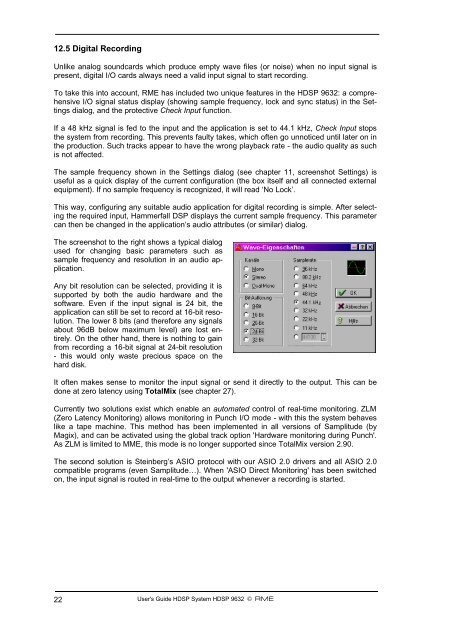Create successful ePaper yourself
Turn your PDF publications into a flip-book with our unique Google optimized e-Paper software.
12.5 Digital Recording<br />
Unlike analog soundcards which produce empty wave files (or noise) when no input signal is<br />
present, digital I/O cards always need a valid input signal to start recording.<br />
To take this into account, <strong>RME</strong> has included two unique features in the H<strong>DSP</strong> <strong>9632</strong>: a comprehensive<br />
I/O signal status display (showing sample frequency, lock and sync status) in the Settings<br />
dialog, and the protective Check Input function.<br />
If a 48 kHz signal is fed to the input and the application is set to 44.1 kHz, Check Input stops<br />
the system from recording. This prevents faulty takes, which often go unnoticed until later on in<br />
the production. Such tracks appear to have the wrong playback rate - the audio quality as such<br />
is not affected.<br />
The sample frequency shown in the Settings dialog (see chapter 11, screenshot Settings) is<br />
useful as a quick display of the current configuration (the box itself and all connected external<br />
equipment). If no sample frequency is recognized, it will read ‘No Lock’.<br />
This way, configuring any suitable audio application for digital recording is simple. After selecting<br />
the required input, Hammerfall <strong>DSP</strong> displays the current sample frequency. This parameter<br />
can then be changed in the application’s audio attributes (or similar) dialog.<br />
The screenshot to the right shows a typical dialog<br />
used for changing basic parameters such as<br />
sample frequency and resolution in an audio application.<br />
Any bit resolution can be selected, providing it is<br />
supported by both the audio hardware and the<br />
software. Even if the input signal is 24 bit, the<br />
application can still be set to record at 16-bit resolution.<br />
The lower 8 bits (and therefore any signals<br />
about 96dB below maximum level) are lost entirely.<br />
On the other hand, there is nothing to gain<br />
from recording a 16-bit signal at 24-bit resolution<br />
- this would only waste precious space on the<br />
hard disk.<br />
It often makes sense to monitor the input signal or send it directly to the output. This can be<br />
done at zero latency using TotalMix (see chapter 27).<br />
Currently two solutions exist which enable an automated control of real-time monitoring. ZLM<br />
(Zero Latency Monitoring) allows monitoring in Punch I/O mode - with this the system behaves<br />
like a tape machine. This method has been implemented in all versions of Samplitude (by<br />
Magix), and can be activated using the global track option 'Hardware monitoring during Punch'.<br />
As ZLM is limited to MME, this mode is no longer supported since TotalMix version 2.90.<br />
The second solution is Steinberg’s ASIO protocol with our ASIO 2.0 drivers and all ASIO 2.0<br />
compatible programs (even Samplitude…). When 'ASIO Direct Monitoring' has been switched<br />
on, the input signal is routed in real-time to the output whenever a recording is started.<br />
22<br />
User's Guide H<strong>DSP</strong> <strong>System</strong> H<strong>DSP</strong> <strong>9632</strong> © <strong>RME</strong>
















